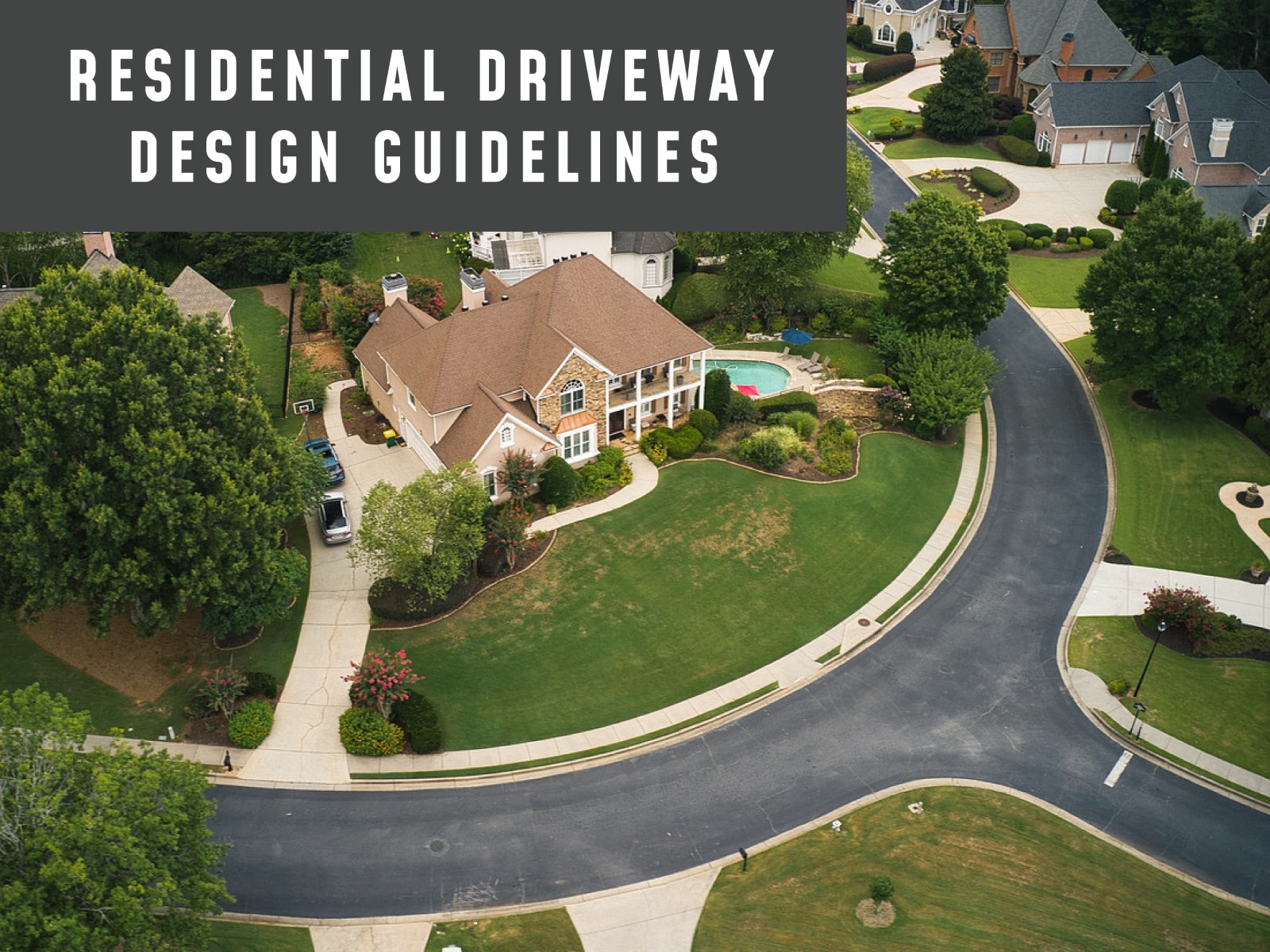The geometric design of driveways is a critical aspect of urban and suburban infrastructure, interfacing directly with public roadways.
The design process requires careful consideration of various elements, such as the driveway's width, curvature, and slope to ensure that it facilitates safe and efficient access for vehicles. Precision in geometric design is paramount to accommodate the diverse needs of all users, which include pedestrians, cyclists, and motorists, while ensuring that the driveways integrate well with existing roads and pathways.
Driveway design isn't merely about aesthetics; it involves a comprehensive understanding of engineering principles and local regulations. Professionals must navigate through a complex array of standards and safety considerations to create driveways that not only serve the functional requirements of private property but also align with public interests. This balance mandates an adherence to regulatory frameworks and a sensitivity towards the potential impact on traffic flow, road safety, and the surrounding environment.
Key Takeaways
- Geometric design encompasses the structural aspects of driveways for accessibility.
- Design processes must align with regulatory standards to ensure safety and efficiency.
- Professional driveway design achieves a balance between private and public interests.
Driveway Design Fundamentals
In driveway design, we prioritize safety, accessibility, and aesthetics. Our goal is to blend these elements effectively within the constraints of space and local regulations.
Concepts and Definitions
Geometric design is the framework that shapes the physical form of the driveway, balancing factors like the driveway width, curvature, and sight distance for safety and functionality. In this context, design elements refer to the various features such as lanes, shoulders, side slopes, and borders that are integral to a driveway's architecture.
We often use terms like "entry radius" and "cross slope" to describe specific features of a driveway's geometry. As we discuss driveway-related terms, it’s key to understand that the entry radius is the curve at the driveway entrance that affects how vehicles enter the property, while the cross slope aids in drainage across the driveway surface.
Key Components of Geometric Design
For us, the geometric design of driveways centers on ensuring that vehicles can enter and exit properties with minimal disruption to traffic flow.
We consider several components:
- Entry and Exit Angles: The angles at which a vehicle enters or exits a driveway must facilitate smooth transitions to and from the roadway.
- Sight Distance: We calculate the required visible area a driver needs to safely exit the driveway onto the road.
- Width and Surface: The driveway width must accommodate the passage of vehicles without causing damage to the landscape or property, and the surface material affects friction and drainage.
By adhering to best practices in geometric design, we aim to craft driveways that are secure, intuitive to navigate, and synergistic with their surroundings.
Regulatory Framework and Standards
In aligning driveway design with regulatory requirements, we pay close attention to access management and Americans with Disabilities Act (ADA) standards to ensure both functionality and compliance.
Access Management Regulations
Access management, a set of techniques to control entry and exit points, is critical for maintaining the efficient movement of traffic and enhancing safety on roadways.
The American Association of State Highway and Transportation Officials (AASHTO) provides guidelines within its "Policy on Geometric Design of Highways and Streets" that influence how driveways should be designed. These regulations often dictate the placement, spacing, and design of driveways.
By adhering to these standards, we aim to reduce conflicts between vehicles and to promote smoother traffic flow.
- Spacing regulations: Enforce minimum distances between driveways to prevent traffic issues.
- Sight distance requirements: Ensure drivers have adequate visibility to enter and exit safely.
- Turning radii: Address the appropriate curvature for driveways to accommodate vehicle types.
ADA Compliance and Design Standards
Driveway designs must also comply with ADA requirements, ensuring accessibility for all users. This includes having slope specifications that accommodate wheelchair users, as well as tactile paving surfaces to guide visually impaired individuals.
- Slope specifications: Maintain a gentle slope to ensure ease of navigation.
- Tactile paving: Implement textured ground surface indicators.
- Width regulations: Ensure driveway paths are wide enough to support wheelchair access.
The Institute of Transportation Engineers (ITE) provides additional resources for integrating access management strategies with ADA design principles to create driveways that are safe and accessible for all road users.
Safety Considerations
When addressing the safety considerations in the geometric design of driveways, we focus primarily on maintaining clear sight distance and ensuring the protection of more vulnerable road users such as pedestrians and bicyclists.
Sight Distance Essentials
Sight distance is a crucial factor in driveway design, as it pertains to the visible range a driver has to safely enter and exit a driveway.
Adequate sight distance allows drivers to perceive and react to other roadway users, such as pedestrians, bicyclists, or oncoming vehicles. According to research, insufficiencies in driveway spacing and the presence of road design elements can negatively impact sight distance. Our goal is to ensure that all users have sufficient time to respond to potential hazards.
Key elements affecting sight distance include:
- Driveway spacing: Closely spaced driveways limit drivers' reaction time.
- Road design elements: On-street parking, landscaping, and signage can obstruct views.
- Land use: The surrounding environment, such as urban or rural settings, influences sight distance requirements.
Pedestrian and Bicyclist Safety
Our approach to pedestrian and bicyclist safety involves integrating sidewalks and bicycle facilities into driveway design. This integration must account for the available stopping sight distance, which is pivotal for the safety of non-vehicular road users.
Urban driveway designs sometimes compromise pedestrian and bicyclist safety by not considering these aspects adequately:
- Including clear crosswalk markings and signage to direct and protect pedestrians.
- Providing designated bicycle paths that are separate from vehicular lanes when possible.
Driveway Location and Spacing
Optimal driveway location and spacing are critical to ensure the smooth functioning of traffic and enhance safety on arterial highways.
Principles of Driveway Placement
When designing driveways, we strictly adhere to access spacing principles that aim to balance vehicular access to property and the operational efficiency of the highway.
We determine the placement of driveways based on the intended use. For instance, commercial driveways require careful consideration of traffic volume and pedestrian safety.
In our design approach, we also consider the visibility needs for drivers exiting driveways while minimizing conflict points.
Spacing and Capacity Analysis
For spacing, rigorous capacity analysis guides our decisions to ensure the uninterrupted flow of traffic. We calculate the minimum driveway spacing based on speed limits and anticipated vehicle queues to avoid back-up onto the main travel lanes. By maintaining appropriate spacing between driveways, we reduce the risk of accidents caused by frequent turning movements and improve operations.
Our capacity analysis helps determine the optimal number of driveways, their placement, and the configuration that best supports efficient traffic flow and access to adjacent land uses.
Design and Operational Features
In designing driveways, we consider both functionality and safety, ensuring that entrances and exits are configured appropriately and the alignment of the driveway facilitates smooth traffic flow and control.
Entrance and Exit Configuration
We prioritize the placement and spacing of both entrance and exit points to accommodate anticipated traffic. It's essential to design driveways with adequate ingress and egress to minimize congestion and enhance safety.
For example, the separation between an intersection and a downstream driveway is critical to prevent bottlenecks. We use criteria like driveway spacing to ensure smooth transitions for vehicles turning into or out of a driveway.
Vertical and Horizontal Alignment
The design of vertical alignment is crucial to maintain the visibility of oncoming vehicles and pedestrians. It affects both safety and the efficiency of traffic movement. A driveway's vertical profile must ensure that vehicles can enter and exit without obstruction.
Similarly, horizontal alignment must be designed to facilitate vehicle movement into and out of the driveway without sharp turns that can cause traffic to slow down unexpectedly or result in conflicts. We incorporate traffic control measures in areas where closely spaced driveways and intersections require drivers to make quick decisions.
Special Considerations for Various Users
When designing driveways, we must account for the diverse needs of all users, which includes ensuring accessibility for motorists, cyclists, pedestrians, and public transportation systems while meeting accessible needs.
Accessibility for Different Modes of Transportation
Driveways are a critical point of interaction for various transportation modes.
Ensuring motorist safety involves maintaining clear visibility and appropriate stopping sight distances. Equally important is the incorporation of bicycle lanes when planning driveway locations, considering the relationship between geometric design features and performance, which can impact cyclists' safety.
For pedestrians, the driveway design must integrate tactile paving and use of curb cuts to cater to those with accessible needs, enabling safe and autonomous movement across driveways. These considerations are critical for creating inclusive environments for all users.
Public Transportation Interfacing
Public transportation, such as buses, requires driveways that accommodate bus dimensions and allow for efficient ingress and egress. Our design takes into account bus turning radii and the importance of pedestrian and bicyclist considerations in the proximity of bus stops to avoid conflicts and ensure safety for all users.
The interface between driveways and public transportation is further enhanced through well-designed queues and pull-in spaces, reducing potential disruptions to the traffic flow and maintaining a safe environment for motorists and passengers alike.
Engineering Practice and Research
In our exploration of driveway design, we focus on the implementation of established guidelines and the integration of cutting-edge research to ensure safety and efficiency.
The NCHRP has been pivotal in setting these standards.
Application of NCHRP Guidelines
Following the guidelines issued by the NCHRP is fundamental to our approach. We rigorously apply geometric design principles to accommodate various types of vehicles, ensure clear visibility, and manage access points effectively. These principles help in mitigating traffic conflicts and enhancing overall road safety.
Recent Advances in Driveway Design
Our engineering practices are also informed by the latest findings in driveway design. The NCHRP Web-Only Document 151 offers insights into emerging trends and technologies that we incorporate to improve the geometric design of driveways.
Technologies like automated vehicle detection and advanced materials contribute to the evolution of driveway standards, optimizing them for current and future transportation needs.








